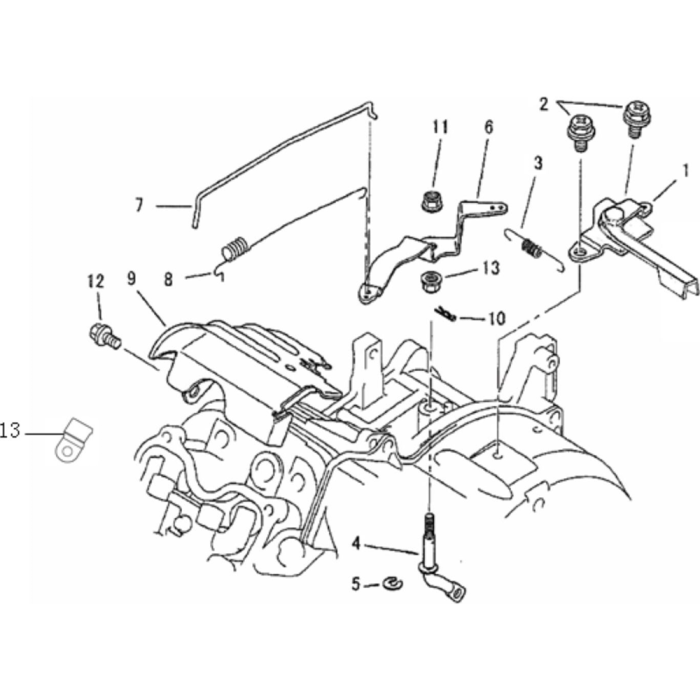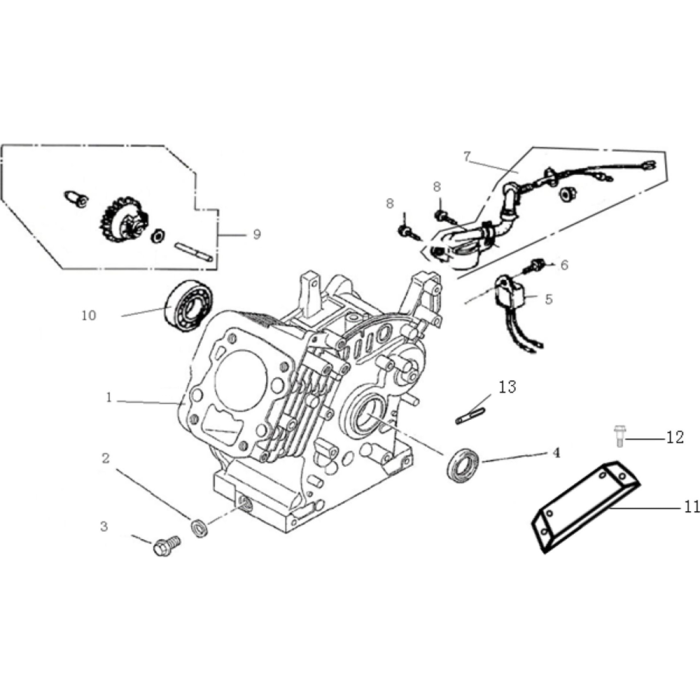So I've fixed the issue with my gas engine powered pressure washer.
I know how aggravating it can be to find a thread that lists your problem but the final solution is never posted. I'll post the rectification here in case someone runs across the thread searching for a possible solution to a similar problem.
First, it wasn't a pump problem. It was an RPM problem. The engine was running too fast which was spinning the pump too fast and causing it to produce too much GPM/pressure. The unloader valve cycling open/closed was doing exactly what it is supposed to do in order to protect the pump.
The RPM problem was caused by a governor issue.
For those that don't know how a governor actually works on a small engine, here's a primer:
On a governed small engine, your physical throttle handle (IE: the thing with the "rabbit" and "turtle" symbols) does not control the actual throttle blades on the carburetor, it controls spring pressure on the governor arm.
This is going to be a generalization, so your engine manual will be the final word on how your particular engine is governed. All the governed small engines I've owned/worked on use this type of RPM control, so take that for what it's worth.
-The governor arm is usually an "L" shape of some sort (diagram A - item 6). The long leg of the "L" is linked to the carb throttle via a fixed rod (Diagram A - item 7) and is set up to hold the carb wide open with engine "OFF". There's usually a spring there as well (Diagram A - item 8), but all that spring does is to take up "slop" between the carb throttle arm and the governor arm (ie: cheaply mass produced stamped steel pieces have a lot of variance in tolerances) . You don't want the arms and linkages "fluttering" (IE: result of "slop") in a carb control mechanism as that introduces lots of other odd running issues. This spring is usually just a very "light" spring, just enough to eliminate play in the linkage connections.
Diagram A:
-The short leg of the "L" arm is connected to either a stop adjustment or your hand throttle via a "stiff" spring (Diagram A - item 3) . The OEM decides what value of "stiffness" this spring has for a specific purpose (which will become clear in the text below).
-The angle point of the "L" is connected to the governor "rod/shaft" (Diagram A - item 4), which is operated by a flyweight actuated mechanism (usually internal to the engine). This attachment point is the pivot point for the arm. Most "modern" small engines use the fly weight method of actuation as it's more reliable and faster acting than the less commonly used "air vane" style.
Flyweight mechanism is item 9 in the following graphic:
-The governor rod/shaft is also "L" shaped (Diagram A - item 4), but the short leg is down inside the engine so you don't normally see it unless you open up the engine cases.
-As the engine rpm increases, the flyweights are spun outwards (via a gear to the crank or camshaft, this particular engine is geared to the camshaft) and they extend a pin that pushes the governor arm rod/shaft via the short legged end on the shaft. Again, this is all down inside the engine cases so you don't see it.
-So what you have is the exterior "L" shaped arm trying to run the engine WOT via the fixed spring and the linkage to the carb, while the governor mechanism down inside the engine is trying to slam the carb throttle shut (when engine running) by pushing on the governor shaft.
-This "push/pull" fight between the spring on the governor arm and the flyweights inside the engine is what gives you the rpm setting of the engine and what allows the governed engine to adjust itself for varying loads.
IE: As load increases, the rpm drops, the flyweights move inward, the spring pulls the throttle more open and raises RPM when under load. Once the RPM increases and stabilizes at the preset level, the "push/pull" fight between spring and flyweights begins again and keeps the RPM stable at that level. The inverse happens when load is removed.
It might seem counterintuitive at first, but your carb throttle blades should be wide open with the engine "off" and the governor tries to slam it shut when the engine is running. But the system works well to maintain rpm under varying loads and that's all that really matters.
What had happened on my little engine was somehow the governor arm had moved on it's shaft. Perhaps it go bumped while the engine was torn down for cleaning or perhaps I put too much force on it during disassembly and it shifted. Sometimes it's just a "wear" issue and the governor just needs to be readjusted. I'm guessing it was a "bumped" issue. Not sure. A quick reset on the governor mechanism returned it to normal operation and now it runs properly and max RPM adjusts as it should.
I didn't go right to the governor adjustment because as far as I knew, it hadn't been touched so it should have run properly when reassembled. Never "assume" I guess. I know better, but sometimes forget....
Adjustment of the governor on my pressure washer (like most small engines) was simple: Loosen the arm to the governor rod nut/pinch bolt (Diagram A - item 11), hold the governor arm (Diagram A - item 6) at the WOT position, use a screwdriver/wrench to turn the governor rod (Diagram A -item 4) clockwise, then tighten down the nut/pinch bolt (Diagram A - item 11). Then adjust the max RPM if yours is fixed for Max RPM operation, or adjust for idle and max rpm if your throttle is moveable. Check your engine manual for the min/max RPM values.
Note: if working on a direct drive pump like a pressure washer, do not run the engine without water flowing through the pump or you
WILL score the pump bores/pistons and very likely ruin it. Never run a pressure washer pump without water flow and purging the air out of the lines first. You may get away with it a couple times if there's some residual water hanging around in there, but you will eventually roll "snake eyes" and be looking a pump replacement if you don't have a water source connected.
I simply pulled the pump off the engine so I could run the engine and make my governor/rpm adjustments without risking the pump. I was four bolts to get it off and allowed me to clean and re-grease the driveshaft. It's also good to remove the bolts once in a while as they are steel bolts in an aluminum housing in a "wet/humid" environment and if left too long, they will often corrode and ruin the threads when removed. Luckily, mine were alright with just a little corrosion in the bolt threads. I chased the threads and reinstalled the bolts with a little touch of anti-seize to help keep them corrosion free should it ever have to come off again.
A good thing to install on a pressure washer (or any small engine for that matter) is an hour-meter. I have an inexpensive digital inductive one (wraps a wire around the spark plug wire) so it works on all magneto fired small engines (i/e: doesn't need a vehicle battery for power). It also does RPM, which is invaluable when adjusting and confirming the engine is still running properly throughout the seasons. You can't trust your ears when adjusting rpm other than it's higher or lower than when you started. You absolutely want small engines that are oil "splash lubricated" running at the OEM's specified rpm and you don't want them running over spec'd max rpm or you risk tossing a rod out through the block (one of the most common causes of premature "death" for small engines). If you do install an hour/rpm meter, try to get one with a replaceable battery. Many of the inexpensive ones have a "built in battery" and when it dies, you have to replace the whole meter, which defeats the purpose of having and hour-meter in the first place IMHO.
Last thing I have to do is to confirm the RPMs are right for the pump to build it's spec'd pressure, but that will have to wait until the weather gets a little better here. I've got a 5000 psi glycerine filled pressure gauge on the outlet so between the pressure gauge and the RPM gauge it will be a doodle to get the final adjustments dialed in properly. I've currently adjusted the rpm to max out at 3800 rpm and the little engine is quite smooth and sounds very happy there. But this little 87cc four stroke is also spec'd for a max 4400 rpm (idle of 1400 RPM). The pump output will be the final decider where max RPM will ultimately be set, as long as it's not over the engine max RPM. If it is, that will indicate the pump is worn and needs rebuild or replacement, or just deal with a reduced output until it totally dies.
So, barring a final "tweaking": Job done.
I will also say that if you can't find an engine manual on your particular small engine (most "imports" don't have a lot of info out there), search for a "TORO" product that uses the same engine. TORO manuals are typically much better than most of the generic product/owner manuals you get with a product. They actually include engine adjustments, valve clearances, torques, specs parts breakdowns, operational descriptions/specs and internal clearances/wear limits for the engine. They basically cover everything you would need to know to tear it down to the crank and rebuild it.
For example: the little 87cc engine on my Karcher is actually a rebranded "Loncin" LC154F, which is a Chinese import used in multiple rebranded applications across the globe. Very little out there on it as far as engine work goes (even simple things like governor adjustments), even on the OEM's website. They're basically intended to be "unsupported" and "throw away" products.
The Karcher G2000MK owners manual is still available online, but it doesn't even tell you the RPM the engine should be running at, it just says "refer to engine manual". If you're not the original owner (or have lost/thrown it out), you're SOL.
TORO had an engine manual online for the LC154FS (which is used on an older single stage snowblower/sweeper) which gives you all the engine information you could want to repair/rebuild the engine on the Karcher G2000MK. The extra "S" on the end of the engine model simply means "snow", but its still just a "Loncin LC154F".
So here endeth my posting in this thread. There will be no more follow up posts from me as I now consider the matter closed. I'm not on the forum much anymore anyways.
As mentioned, I just wanted to post the actual solution to my problem in the event someone ever runs across it on a search and it might possibly help them out.
Ciao.



